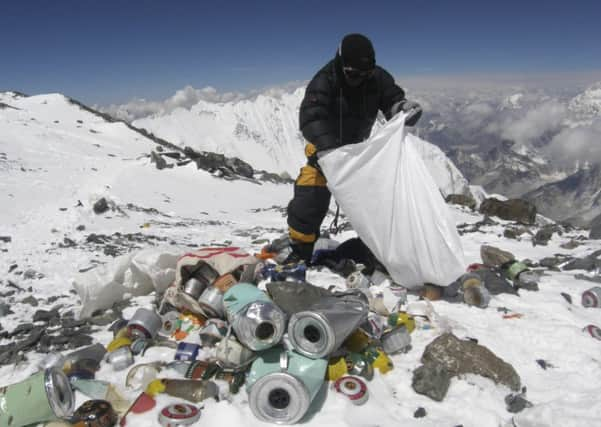Nepalese in crackdown on Mount Everest litterbugs


From this spring, officials at Everest base camp will check each climber descends the mountain with approximately 18lb of trash – the amount the government estimates a climber discards along the route.
Maddhu Sudan Burlakoti, head of the mountaineering department at the tourism ministry, said: “We are not asking climbers to search and pick up trash left by someone else. We just want them to bring back what they took up.”
Advertisement
Hide AdAdvertisement
Hide AdThe goal is to make sure no new waste will be left on Everest, which has earned the nickname “the world’s highest rubbish dump” because of the tonnes of crumpled food wrappers, shredded tents and spent oxygen cylinders left behind. The government has long asked climbers not to leave rubbish, but there was no system in place to check what people brought down.
There also was little or no enforcement despite threats – which were rarely carried out – to withhold $4,000 (£2,400)climbing deposits for pollution.
The government did not say what action it would take against climbers who descend without the 18lb of rubbish.
Some 230,000 people – nearly half of Nepal’s yearly foreign visitors – travelled to the country last year to climb the Himalayas, with 810 attempting to scale Everest.
More than 4,000 climbers have scaled the 29,035ft summit since 1953, when it was first conquered by New Zealand climber Edmund Hillary and his Sherpa guide Tenzing Norgay.
Hundreds have since died making the attempt, while many have succeeded with help from oxygen tanks, porters and Sherpa guides.
Nepalese authorities have never had much control over what happens on the upper reaches of the mountain.
Private trekking companies organise logistics and report any problems. They are also left to clear the rubbish, launching yearly expeditions to bring down whatever has not been buried by snow and ice.
Advertisement
Hide AdAdvertisement
Hide Ad“There is no way to say how much garbage is still left on Everest,” said Dawa Steven Sherpa, who has been leading Eco Everest Expeditions since 2008. “It is impossible to say what is under the ice.”
However, sherpas and environmentalists applauded the government’s clean-up rules.
Ang Tshering, president of Nepal Mountaineering Association, said: “This should have been introduced a long time back. It is going to make sure that climbers obey the rules.”
The Nepalese – who consider the mountain they call Sagarmatha to be sacred – sometimes attribute climbing deaths to bad karma earned through disrespecting the mountain.
Sagarmatha means “forehead of the sky,” in Nepali, while the Tibetan name for Everest is Chomolangma, or “goddess of the snow”.
The mountain is the centre of the tourist industry, which earns the country $3.3 million each year in climbing fees. The industry also supports tens of thousands of Nepalese hotel owners, trekking guides and porters.
If the rubbish-checking model at Everest base camp is successful, it will be rolled out to other climbing routes, the tourism ministry said.
Last month, the government said it would slash Everest climbing fees to $11,000 a person next year to attract more mountaineers, who currently pay $25,000.